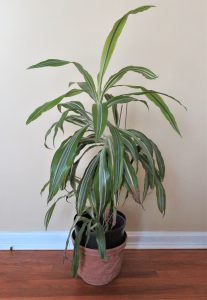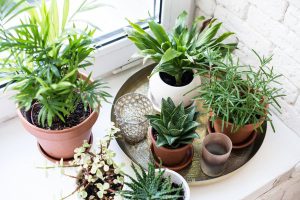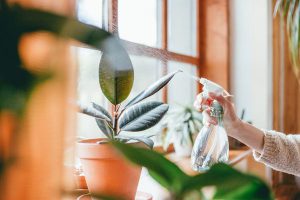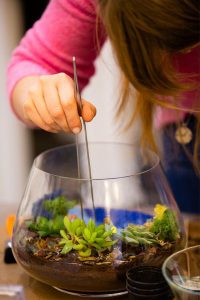
After several mild winters, NorthEast Florida has experienced several recent cold spells where we have turned up the thermostats in our homes. Homes typically have low humidity levels anyway but during the winter, heat pumps and other heating sources can create dry air throughout the house. Humidity may drop to less than 20%. While that might help your allergies, it is uncomfortable generally for houseplants. Many houseplants have tropical origins where typical humidity levels can reach up to 80%.
Most houseplants do not need as much water applied to the soil during the winter but humidity levels should be considered. It is best to grow plants in an environment close to their natural environment, think “Right Plant, Right Place,” so putting a plant that likes high humidity in an environment with low humidity is a challenge for the plant.
So how do you tell if you need to increase the humidity of your indoor plants during the winter months and how can this be accomplished?
The first step is to try and determine how much humidity your houseplant requires. Knowing the origin of the species is a good starting point. If they are native to a mostly humid habitat, then you know that is the condition they prefer. Cacti typically come from the desert, though there is one variety native to Florida, while, orchids, bromeliads, and peace lilies, to name just a few, are all native to South and Central America.
Warning Signs
Next, look for signs of humidity stress, such as brown leaf tips, yellow leaf edges, and flowers and leaves that shrivel up or die.
How to Increase Humidity
Once you have determined that higher humidity is required you may think that the most obvious choice is to use a humidifier. A humidifier is certainly a good option if you have a room full of plants that like constant humidity. But if you only have a few indoor plants or brought plants inside during cold weather, there are simpler ways to increase humidity.
- Group your houseplants according to humidity requirements. Since plants release moisture through their leaves, you can create a humid microclimate that will benefit all the plants. However, plants which require lower humidity, such as succulents and sansevieria, (that Mother-in-law plant is also a succulent) should be grouped separately from the plants that like higher humidity levels.


- Mist your plants. Keep a spray bottle filled with water near the plants and spray occasionally. However, never mist plants with velvety leaves, such as African violets, as it can encourage disease to form and spread.
- Place containers of water near the plants. Vases filled with water and cut flowers will add humidity in the immediate area of the plants as the water evaporates while adding an attractive decorative touch to the room. Bromeliads that store water in the base of their leaves may also provide some additional humidity.
- Put plants in trays or saucers with stones and water. Put an inch or more of pebbles or small stones in each tray, fill with water halfway up the stones and set the plants on the stones. Do not let the plants sit directly in water which could encourage root rot. Replace the water in the tray each time you water the plants so it doesn’t become a breeding ground for bacteria and insects. Specialized humidity trays for plants are available in many garden centers and online.
- Use a terrarium. If you have smaller plants with high humidity requirements, consider using terrariums which will allow the moisture to accumulate and fall back on the plants. If you have an unused aquarium stored in your garage, it would make an excellent temporary terrarium during the winter months. Just remember to remove the top occasionally to allow some air circulation.

Keeping your houseplants healthy during winter months is not difficult. But we do need to keep an eye on them and watch the temperature and humidity levels in our homes. Houseplants in NorthEast Florida winters can be a great way to keep your gardening passion going throughout the year. And keep up that daily weeding you put on your New Year’s Resolutions!
This blog was written by native garden enthusiast and Master Gardener, Walter Bryant. Walter has gardened in Northeast Florida winters for many years and is now an adept yarder. He is a frequent contributor to this blog.
 0
0
